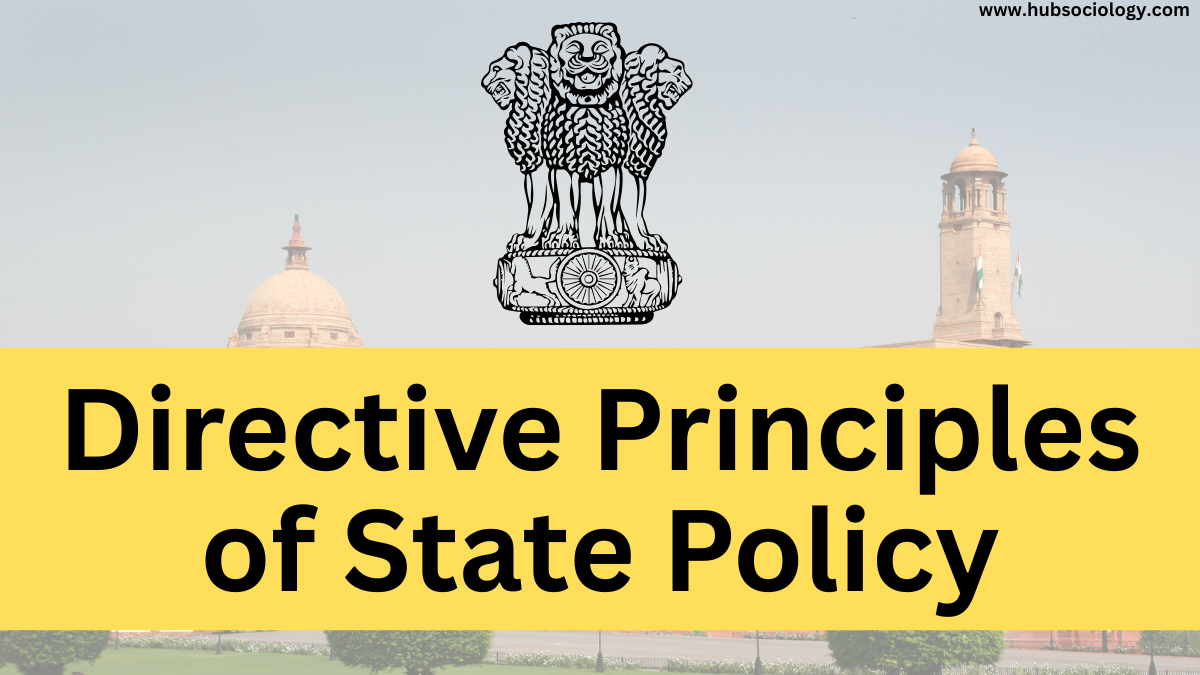Introduction
The Directive Principles of State Policy (DPSP), enshrined in Part IV (Articles 36 to 51) of the Indian Constitution, serve as a moral and philosophical compass for governance in India. While not legally enforceable, they provide a framework for the state to formulate policies aimed at establishing a just and egalitarian society. From a sociological standpoint, the DPSP play a crucial role in shaping social policies that address inequality, poverty, education, health, and social justice.
This article examines the Directive Principles as a foundational source of social policy in India, analyzing their impact on welfare measures, social justice, and equitable development. It also explores the challenges in their implementation and their relevance in contemporary Indian society.

Sociological Significance of Directive Principles
Sociology studies how social structures and state policies interact, with a focus on how governance and legislation affect social change. The DPSP are significant because they reflect the constitutional vision of a welfare state, aiming to reduce disparities and promote social harmony.
1. Promoting Social Justice and Reducing Inequality
The DPSP emphasize reducing economic and social inequalities (Article 38), ensuring equal pay for equal work (Article 39(d)), and securing the right to work and education (Article 41). These principles have influenced key social policies such as:
- Land Reforms – Abolition of zamindari, land redistribution, and tenancy reforms were initiated to reduce agrarian inequality.
- Reservation Policies – Affirmative action for Scheduled Castes (SCs), Scheduled Tribes (STs), and Other Backward Classes (OBCs) was institutionalized to correct historical injustices.
- Minimum Wages Act (1948) – Ensures fair wages for laborers, reducing exploitation.
From a sociological perspective, these policies aim to restructure the traditional caste and class hierarchies that have perpetuated inequality in India.
2. Welfare State and Social Security
The DPSP advocate for:
- Right to Work (Article 41) – Leading to schemes like MGNREGA (2005), which guarantees 100 days of employment to rural households.
- Right to Education (Article 45) – Realized through the Right to Education Act (2009), ensuring free and compulsory education for children aged 6-14.
- Public Health (Article 47) – Policies like Ayushman Bharat (2018) aim to provide healthcare access to marginalized groups.
These policies reflect the state’s commitment to social welfare, ensuring that basic needs are met, particularly for the underprivileged.
3. Gender Equality and Women’s Empowerment
Article 39(a) and (d) emphasize gender equality in wages and opportunities. Article 42 mandates maternity benefits, leading to laws like the Maternity Benefit Act (1961) and the Beti Bachao Beti Padhao campaign. These policies challenge patriarchal norms and promote women’s participation in the workforce.
4. Protection of Marginalized Groups
- Article 46 promotes the educational and economic interests of SCs, STs, and other weaker sections.
- Forest Rights Act (2006) recognizes the rights of tribal communities over forest land.
These measures attempt to integrate marginalized groups into mainstream development, addressing historical exclusion.
Challenges in Implementation
Despite their significance, the DPSP face several implementation challenges:

1. Economic Constraints
Many welfare policies require substantial financial resources. For instance, universal healthcare and quality education remain underfunded, leading to disparities in access.
2. Political Will and Bureaucratic Hurdles
Social policies often face delays due to political priorities and bureaucratic inefficiencies. For example, land reforms remain incomplete in many states due to resistance from powerful landowners.
3. Social Resistance
Traditional caste and gender hierarchies often hinder progressive policies. For instance, despite laws, manual scavenging persists due to caste-based occupational discrimination.
4. Judicial Non-Enforceability
Since DPSP are not legally binding, governments may neglect them without immediate repercussions. Courts can only encourage their implementation but cannot mandate them.
Relevance in Contemporary India
In the era of globalization and neoliberalism, the DPSP remain crucial in ensuring that economic growth does not exacerbate inequalities. Recent policies like:
- Food Security Act (2013) – Aligns with Article 47 (nutrition and public health).
- Digital India and Skill Development – Reflect Article 41 (right to work and education).
- Environmental Protection Laws – Derived from Article 48A (protection of the environment).
These initiatives show that the DPSP continue to guide social policy in modern India.
Conclusion
From a sociological perspective, the Directive Principles of State Policy serve as the ideological foundation for India’s social policies. They address structural inequalities, promote welfare, and strive for an inclusive society. However, their non-justiciable nature and implementation challenges limit their full potential.
For India to achieve true social justice, greater political commitment, public awareness, and institutional reforms are necessary. The DPSP, if effectively realized, can transform India into a more equitable and just society, fulfilling the constitutional vision of socio-economic democracy.

Highly Recommended Books
- Social Policy: Themes and Approaches by Paul Spicker – Amazon Link – https://amzn.to/45DSFOY
- Sociology: A Guide to Problems and its Literature by T.B. Bottomore – Amazon Link – https://amzn.to/4dMG7ah
- PUBLIC POLICY AND POLITICS IN INDIA by Kuldeep Mathur – Amazon Link – https://amzn.to/4jxlUXe
Topic Related Questions
5-Mark Questions (Short Answer Type)
- Define Directive Principles of State Policy (DPSP) and mention any two Articles related to social justice.
- How do Directive Principles promote social welfare in India? Give two examples.
- Explain the significance of Article 39 in ensuring gender equality in India.
- What is the role of DPSP in shaping India’s education policies?
- Why are Directive Principles non-justiciable? Explain briefly.
- How has Article 47 influenced public health policies in India?
- Mention two social policies derived from DPSP that aim to reduce economic inequality.
- What is the relationship between DPSP and Fundamental Rights in the Indian Constitution?
- How does MGNREGA reflect the ideals of Directive Principles?
- Briefly discuss the impact of DPSP on tribal welfare policies in India.
10-Mark Questions (Descriptive Answer Type)
- Discuss the role of Directive Principles in shaping India’s social policies with reference to education and health.
- Analyze how DPSP have contributed to the empowerment of marginalized communities in India.
- Explain the influence of Directive Principles on labor welfare laws in India.
- “Directive Principles aim to establish a welfare state.” Justify this statement with suitable examples.
- Critically examine the challenges in the implementation of DPSP in India.
- How have land reforms in India been guided by the Directive Principles of State Policy?
- Discuss the significance of Article 38 and Article 46 in reducing social and economic inequalities.
- Evaluate the impact of DPSP on women’s empowerment in India.
- How do Directive Principles address environmental concerns? Explain with relevant examples.
- Compare the nature of Fundamental Rights and Directive Principles in the Indian Constitution.
15-Mark Questions (Long Essay Type)
- “Directive Principles of State Policy serve as the foundation of India’s social welfare system.” Discuss this statement with sociological insights.
- Critically analyze the role of DPSP in shaping India’s reservation policies for SCs, STs, and OBCs.
- Evaluate the effectiveness of Directive Principles in promoting social justice and reducing caste-based discrimination in India.
- How have Directive Principles influenced India’s labor and employment policies? Discuss with relevant case studies.
- “The non-justiciable nature of DPSP limits their effectiveness.” Do you agree? Argue with sociological perspectives.
- Examine the contribution of DPSP in the formulation of India’s rural development policies.
- Discuss the role of Directive Principles in environmental conservation and sustainable development in India.
- How do Directive Principles reconcile economic growth with social welfare? Explain with examples.
- “The implementation of DPSP faces structural and ideological challenges.” Critically analyze this statement.
- Assess the impact of Directive Principles on India’s food security and public distribution system.
Additional Higher-Order Thinking Questions (For Research & Debate)
- Should Directive Principles be made legally enforceable? Discuss the pros and cons.
- How do DPSP align with the Sustainable Development Goals (SDGs)?
- Compare India’s DPSP with the welfare policies of other democratic nations.
- How can technology and digital governance improve the implementation of DPSP?
- What reforms are needed to strengthen the role of DPSP in modern India?
